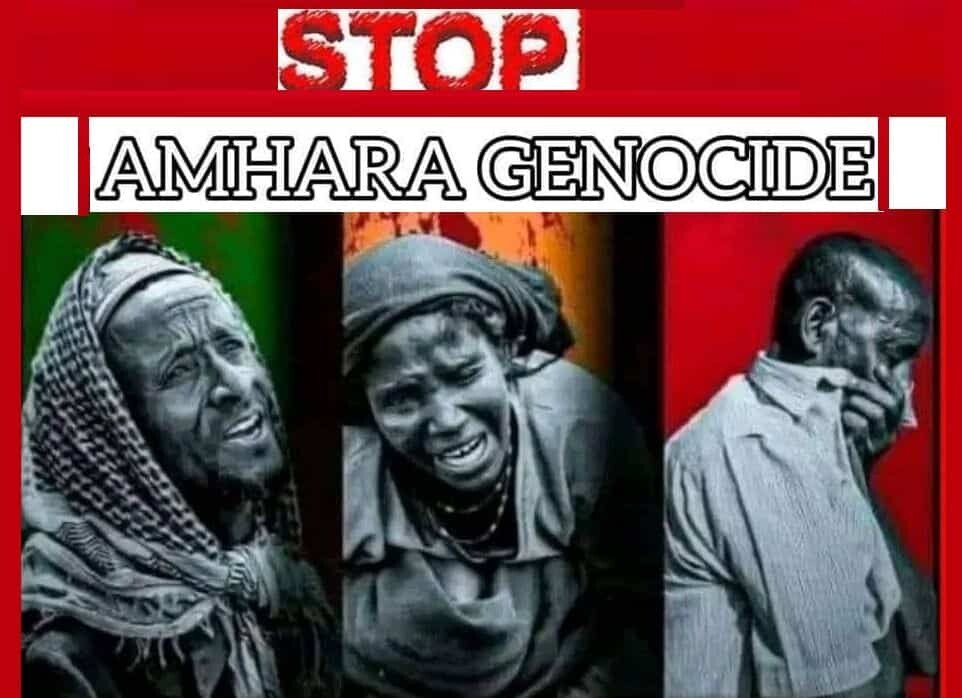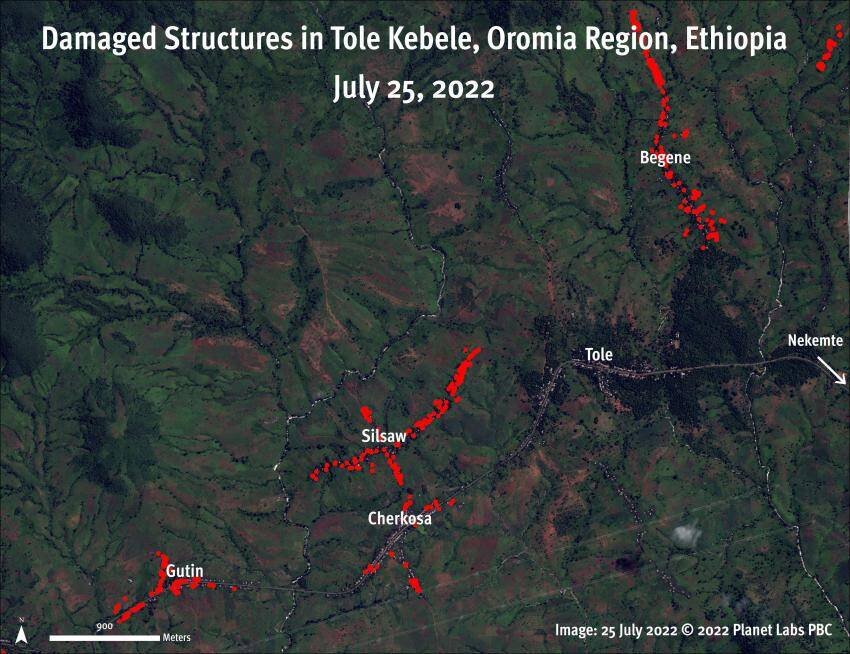
Human Rights Watch

Armed Group Kills Hundreds of Amharas in June Massacre; Independent Inquiries Needed

Distribution of approximate 480 damaged structures destroyed by fire in five villages in Tole kebele, Gutin, Silsaw, Chekorsa and Begene as of July 25, 2022. These numbers might be an underestimate, as it was only conducted within the area covered by the satellite imagery, and additional structures might be also affected. Satellite image: 25 July 2022. © 2022 Planet Labs PBC. Analysis and graphics © 2022 Human Rights Watch
(Nairobi, August 31, 2022) – An armed group killed several hundred Amhara civilians in western Oromia in June 2022 while Ethiopian security forces did little to protect them, Human Rights Watch said today. Nearly three months later, the Ethiopian government has failed to provide adequate shelter or meaningfully address the serious health and protection concerns of surviving residents.
For eight hours on June 18, heavily armed assailants shot and killed about 400 Amhara civilians, including many women and children, in villages in Tole and Sene kebeles (wards). The unidentified assailants also burned and destroyed hundreds of homes and businesses, and looted livestock and other property. Satellite imagery analysis corroborated the burning of at least five villages and the destruction of approximately 480 structures. Despite warnings, government security forces stationed nearby did not arrive until hours after the attack.
“Armed attackers destroyed one village after another, killed entire families with unmitigated cruelty, all while nearby government forces appeared to do nothing,” said Laetitia Bader, Horn of Africa director at Human Rights Watch. “This is just the latest such massacre for which the Ethiopian government needs to do more to ensure credible and independent investigations, identify those responsible, and ensure adequate assistance reaches everyone in need.”
Since 2019, government forces and the Oromo Liberation Army (OLA) armed group have been fighting in western Oromia, resulting in serious abuses against Oromo and minority communities. Ethiopian authorities alleged that the OLA was responsible for the June massacre and other attacks. The OLA accused a government militia of carrying out the attacks and called for an independent investigation.
Between June and August, Human Rights Watch interviewed 25 people by phone, including 19 witnesses and relatives of victims from 5 villages: Gutin; Chekorsa; Silsaw; Begene, in Tole kebele in western Oromia; and a village in neighboring Sene kebele in the Benishangul Gumuz region. Human Rights Watch obtained lists of those killed from residents and analyzed satellite imagery collected before and after the attack. From April to May 2021, Human Rights Watch also interviewed 12 witnesses and family members of a similar attack in Bone kebele, in Babo Gembel district in western Oromia, and conducted follow-up interviews in August 2022.
On the morning of June 18, as male residents left to tend to their crops on nearby farmland or to go to the market, leaving woman and children in the villages, groups of heavily armed men unexpectedly attacked villages in Tole and Sene kebeles.
A farmer from Gutin said he first heard gunfire and saw smoke rising from the direction of Silsaw, a village north of the main asphalt road and near Gutin and Chekorsa. “I ran toward my house and noticed the area encircled by gunmen,” he said. “I took my children to the bush for safety and hid in a tree near the village. The gunmen were … fully uniformed and armed … I heard them saying: ‘Finish them. Don’t Leave. End them.’”
A woman from Chekorsa escaped with her five children to nearby maize fields. The attackers pursued them:
My 8-month-old child started crying. I heard an attacker say, ‘Look there, look there …’ before they shot in our direction. They shot my baby dead. I wrapped the dead body with some clothes I was wearing. My other child was shot in her back; the bullet came out around her neck … I then pressed my injured child against my chest, and I prayed to Allah to save her life
Her older child survived but required two weeks of hospital treatment.
The attacks lasted several hours in some villages, including until 2 p.m. in Gutin and longer in others. Five residents said they made numerous frantic calls to district authorities for help, and to federal and regional government security forces stationed in Jogir, about 17 kilometers from Tole, as well as to a military camp in Didessa. A small contingent of Ethiopian military forces arrived only at 4 p.m., after the attackers had left. Residents then began returning home, where they witnessed the aftermath of the onslaught, and began burying those killed in mass graves.
In Silsaw, residents found bodies throughout the village, including about 29 in the mosque compound. “From a single family, five, six people were killed,” said a 20-year-old woman. “In other cases, families lost 20 people.” In Gutin, residents found 12 charred bodies among the remains of a burned grass house.
Three residents involved in burying victims believed that over 400 people had been killed in at least 6 villages. Community leaders, who gathered lists of those killed and property destruction, estimated that at least 112 were killed in Silsaw, 105 in Chekorsa, 37 in Gutin, 72 in Begene, 16 in Hayaw, and 50 in Sene kebele. At a June 30 media briefing, a spokesperson of the Office of the Prime Minister said that the bodies of 338 people had been identified.
The attacks in Tole and Sene mirror other killings of Amhara civilians in western Oromia. Less than two weeks later, the media reported that armed groups attacked predominantly Amhara civilians in Hawa Gelan district, Kellem Wellega Zone, killing scores. A March 2021 attack on Amhara civilians in Bone kebele, West Wellega Zone, similarly left scores dead.
Survivors from Tole and Sene said that fear of continued attacks in the area, and insufficient protection and humanitarian support was forcing many residents to leave Oromia.
The United Nations Office for the Coordination of Humanitarian Affairs (OCHA) said that at least 4,800 people were displaced from Tole, and that more than 500,000 had been displaced in western Oromia due to the conflict there.
OCHA also reported that it was hard for aid groups to get access to the region because of access restrictions, inadequate funding, and a lack of humanitarian presence. Ethiopian authorities need to create a conducive environment for aid delivery, Human Rights Watch said.
The Ethiopian authorities’ immediate response to the attack was to announce that they would intensify “law enforcement measures” against armed groups. On July 6, Ethiopia’s parliament authorized the establishment of a special committee to investigate violence against civilians in several regions in Ethiopia, including Oromia, and to make recommendations.
But people in Tole, Sene, and Bone kebeles said there have been little signs of investigations so far. The government should provide regular public updates on its investigations, and its steps to curtail abuses by armed groups as well as federal and regional security forces and militias, Human Rights Watch said.
Both the UN High Commissioner for Human Rights Michelle Bachelet and the African Union Chairman Moussa Faki called for independent investigations into the attacks in western Oromia. In a June 30 Oral Update before the UN Human Rights Council, the chairperson of the UN International Commission of Human Rights Experts on Ethiopia expressed alarm at atrocities against civilians in Ethiopia, including western Oromia, and urged member states to provide the commission with experienced investigators and other support.
“Communities in western Oromia have been left reeling from repeated attacks and are living in fear of the next attack,” Bader said. “Ethiopian authorities should urgently move beyond promises to act and provide urgent and adequate humanitarian assistance to affected communities, and support for credible independent investigations.”
Conflict in Western Oromia
Since 2019, Ethiopian government forces and the Oromo Liberation Army (OLA) armed group have engaged in an armed conflict in western Oromia. The OLA was previously the military wing of the Oromo Liberation Front (OLF), a once-banned political opposition group, that fought a low-level insurgency for the self-determination of Oromos for decades.
After Prime Minister Abiy Ahmed assumed office in April 2018, the government reached an agreement with various opposition groups, including the exiled leaders of the Oromo Liberation Front in Eritrea, who agreed to lay down arms, reintegrate, and commit to a peaceful political struggle. However, negotiations soon broke down.
By early 2019, the government had established military command posts in western and southern Oromia. Federal and regional security forces began coordinated military operations against the OLA. In April 2019, the OLA formally broke its ties with the OLF and continued its armed operations.
The conflict has resulted in serious human rights abuses. Government forces have carried out summary executions, arbitrary arrests, and detentions of Oromos, and have at times cut communications in the area. The OLA has killed government officials and attacked non-military government offices. Unidentified armed assailants have also been implicated in killings, abductions, destruction of homes, and mass displacements of ethnic Amhara communities. Residents of Tole kebele in western Oromia said that OLA fighters in the neighboring hills for the past three years have abducted people and demanded ransom.
Human Rights Watch documented a March 30, 2021, attack on Babo Gembel district, West Wellega Zone. At around 8 p.m., gunmen surrounded Sedeka village, in Bone kebele, forced the Amhara residents to gather for a meeting, and shot 28 dead. A man who had fled the village as residents were being gathered said that the armed men spoke Afaan-Oromo, the Oromo language, and had distinctive long hair, which residents said was common among OLA fighters. He climbed a tree and stayed there until 2 a.m., “I later heard gunfire,” he said at the time. Residents called for help from the Oromia regional special forces, who were stationed about 30 minutes away, but they didn’t arrive until 2 a.m., long after the attack had ended.
One village leader lost his brother and his sister-in-law in the attack. “We had just celebrated their marriage on Thursday , and they were then killed on Tuesday evening,” he said. “After all the preparations to celebrate their marriage, we began to prepare for their funeral … A mother of a 15-day-old baby was also among the killed.”
Attacks in Tole and Sene Kebeles, June 18
On June 14, the OLA clashed with government forces in the Gambella region, and in Gimbi town, in western Oromia, 49 kilometers from Tole kebele. Around June 17, government security forces stationed in Tole, along with a small number of local militiamen and Oromia police, left the area without explanation, several local residents said.
In the early hours of June 18, residents in several villages in the adjacent Tole and Sene kebeles saw armed men gathering. They said the attackers wore a mix of civilian clothes and uniforms worn by the Oromia regional special forces, militias, and the former Ethiopian national military uniform. They later noted that they spoke in Afaan Oromo and some of the armed men had long hair.
At 7 a.m., a farmer in Silsaw village and a kebele official, among others, called various officials and security forces for protection and support. The official said, “When I first called, they said they couldn’t take action, without discussion and reaching an agreement with the zone .”
Around 9 a.m.,
https://zehabesha.com/ethiopia-civilians-in-western-oromia-left-unprotected/

No comments:
Post a Comment